A pink blueberry is like a pink orange: it’s a gimmick, but it works. I grow a Cara Cara orange tree and I grow a Pink Lemonade blueberry bush because they taste as good as their traditional counterparts, plus they dazzle the eyes.
But should you grow a Pink Lemonade blueberry bush? Let me share my experience with the variety to help you decide.
Berry characteristics
The other day I forced my three children to take a blind taste test of various blueberries from our yard. They really complained.
Before the test, I asked which they like better, pink or blue blueberries. They all said pink immediately.
“Do you think you can tell the difference between the two if you couldn’t see which you were eating?”
“Definitely,” said my daughter.
She couldn’t. Neither could one of my sons, but my other son did guess correctly.
And after I gave each of them a pink blueberry and a blue blueberry while blinded and asked which berry they liked the best, my daughter and older son unknowingly chose the blue while my younger son chose the pink.
At the end, I asked again, “Which do you like more, pink blueberries or blue?”
“Pink,” they all still said.
Color is that influential, I guess.
Other than color, my assessment of the Pink Lemonade blueberries is that they have a thinner, softer skin compared to the blues that I grow, and have a sweeter, milder flavor. They are also medium in size (not as big as berries of the O’Neal variety, for example).
Bush characteristics
I planted my Pink Lemonade blueberry bush here in Southern California 12 years ago, in 2012. I’ve found that it is slightly more upright than the other varieties I have grown. I’ve grown Sunshine Blue, Bountiful Blue, O’Neal, Misty, Emerald, Gulf Coast, and Jubilee). Pink Lemonade’s leaves are narrow and have serrated margins.
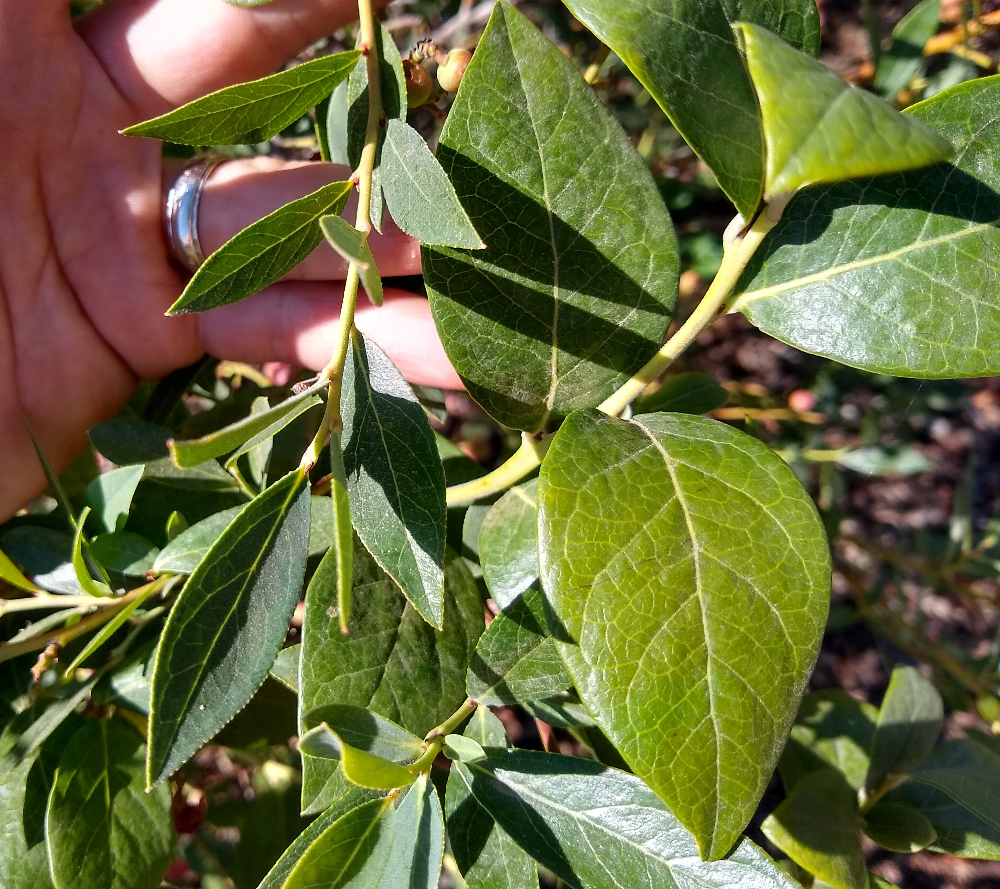
Some other varieties have leaves with more blue and gray in them compared to the leaves of Pink Lemonade.
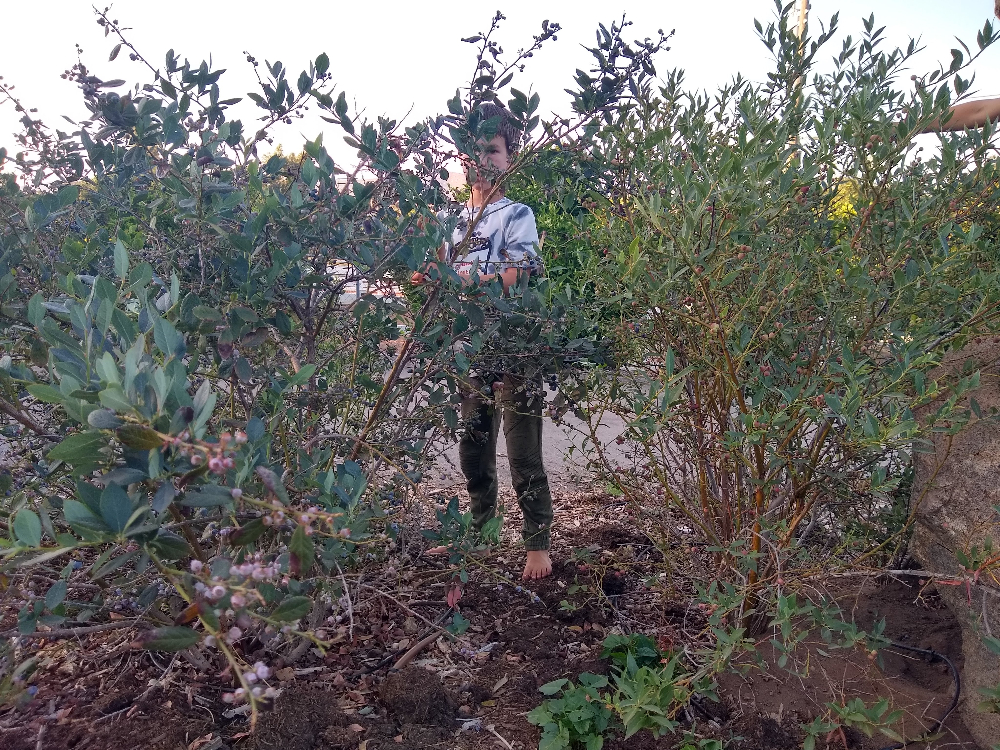
My Pink Lemonade is very productive but still not quite as productive as a couple others. Sunshine Blue and Emerald are two that are slightly more productive.
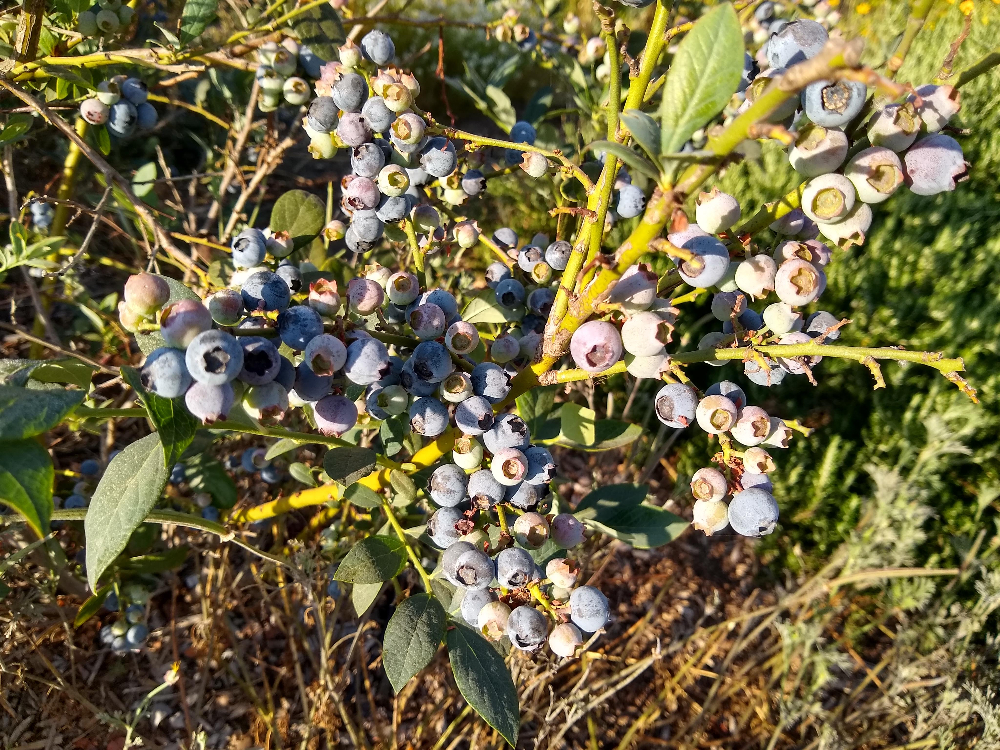
Its season is on the late end. We start eating Pink Lemonade berries in June and continue into August whereas some of the other varieties are ready to pick starting in March but are finished in June. Sunshine Blue’s season, for example, is almost over when Pink Lemonade’s season starts.
On the bush, the Pink Lemonade blueberries turn from green to yellow to pink when fully ripe.
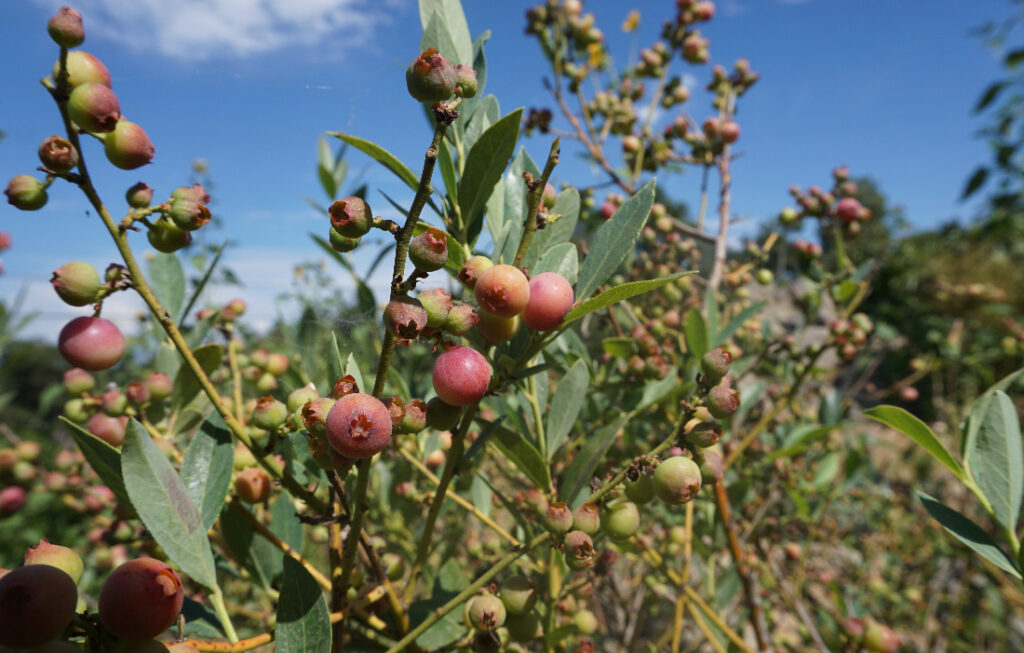
As for heat tolerance, Pink Lemonade shows as much as any other variety in my yard. It gets over 100 here (Ramona, San Diego County) often. As I write this profile, it is 101.
And as far as chilling requirements, my Pink Lemonade bush was first planted in my previous yard located two miles from the ocean near Balboa Park in San Diego, where chill hours were few. There it fruited fine.
There near the ocean, we lived in a shady canyon and the Pink Lemonade blueberry bush also fruited fine in that reduced sunlight although it certainly produces better now that it’s in full sun.
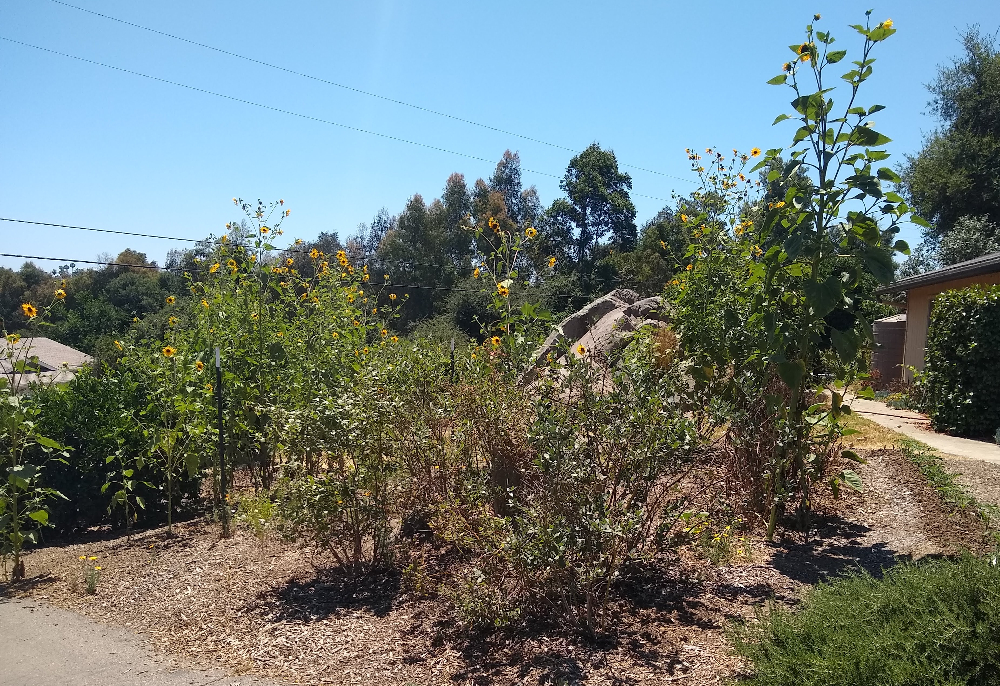
(See my post on growing blueberries in general in Southern California for more on the sun topic and more.)
Variety background
Mark Ehlenfeldt developed the Pink Lemonade blueberry while working for the Agricultural Research Service of the U.S. Department of Agriculture in New Jersey. In 1991, Ehlenfeldt crossed a variety called Delite with a variety called NJ 89-158-1 to get Pink Lemonade.
Delite is a blue blueberry of the type called Rabbiteye, which is a small type that is native to the Southeastern part of the U.S. (Delite was developed at the University of Georgia.) Rabbiteye blueberries also go by the botanical names Vaccinium ashei or Vaccinium virgatum.
NJ 89-158-1 is the female parent of Pink Lemonade, and it is the one with pink-fruited blueberries in its ancestry. The parentage of NJ 89-158-1 is mostly of a type called Highbush, or Northern Highbush, which is a bigger plant that is also native to the Southeastern U.S. but whose native habitat extends north into Canada. Highbush goes by the botanical name Vaccinium corymbosum.
(The classification of blueberries into subgroups is discussed in this article, in case you’re interested.)
You can see a diagram of the family tree of Pink Lemonade in this article by Ehlenfeldt and his colleague Chad Finn.
While Pink Lemonade is the best known pink blueberry, there are others. For example, released at the same time as Pink Lemonade (2005) was a variety called Pink Champagne (tested as G-435), and in 2004 a variety called Florida Rose was patented and released.
Long before these were a couple of varieties around in the 1930s, called Redskin and Catawba, that F.V. Coville described as “red-cheeked albinos.”
Should you grow a Pink Lemonade blueberry bush?
I don’t know how Pink Lemonade performs on its own. I’ve only grown it and only seen it grown in other yards in proximity to other blueberry varieties which can provide cross-pollination. So Pink Lemonade might not be a good single blueberry bush to grow, I’m not sure.
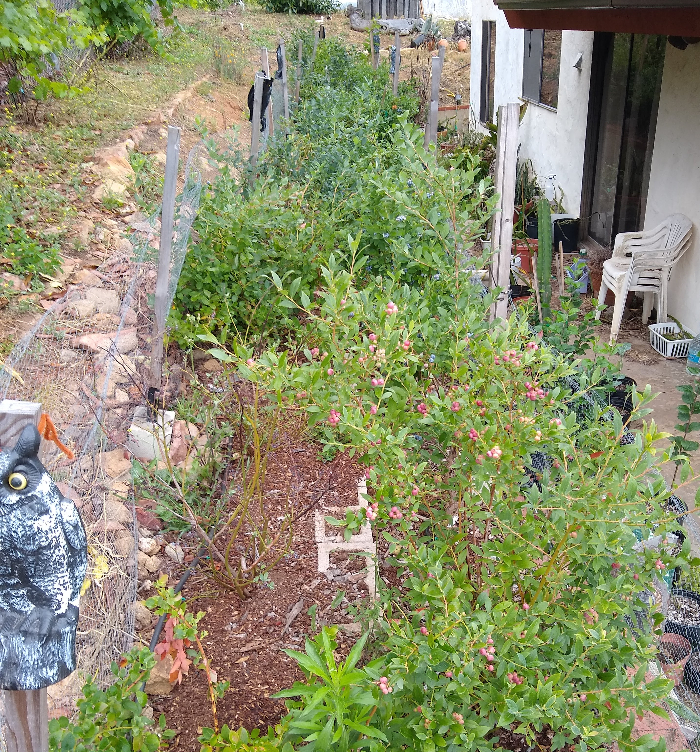
There are blueberry varieties that are a bit more productive than Pink Lemonade, and there are varieties that have larger berries, and you might like the less sweet, grape-like flavor of most blue blueberry varieties. Those are my main caveats.
But I would not remove Pink Lemonade from my collection. I like the bush and the berries, and my kids love them.
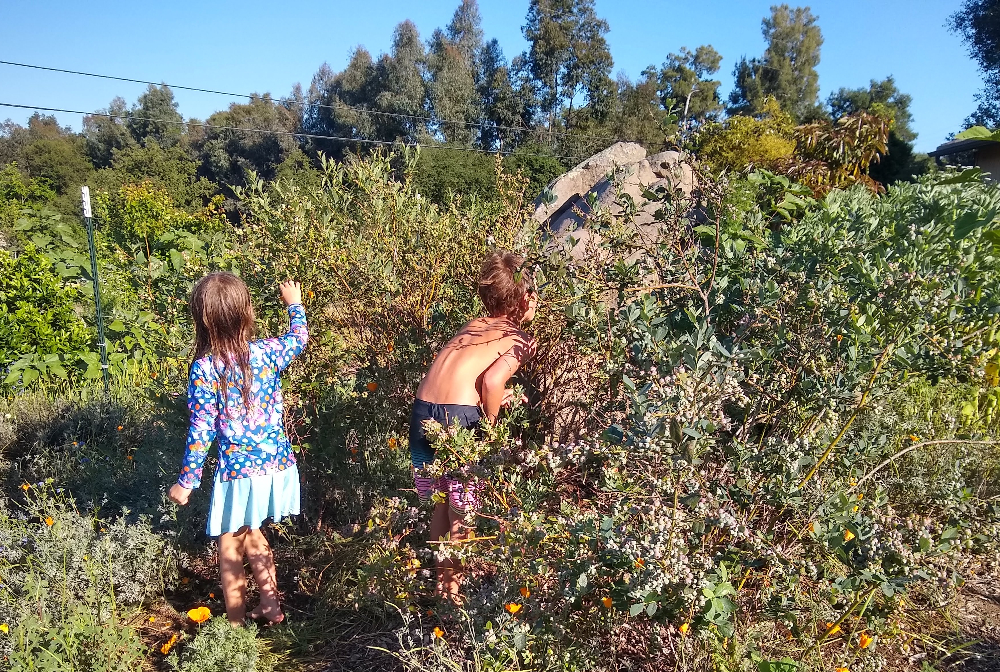
If you have kids, Pink Lemonade will be a hit. The other day my daughter had a friend over and they ran outside to pick blueberries. “Guys, I call all the pink berries!” said the friend.
Thank you for your support so I can keep this website ad-free!
All of my Yard Posts are listed here

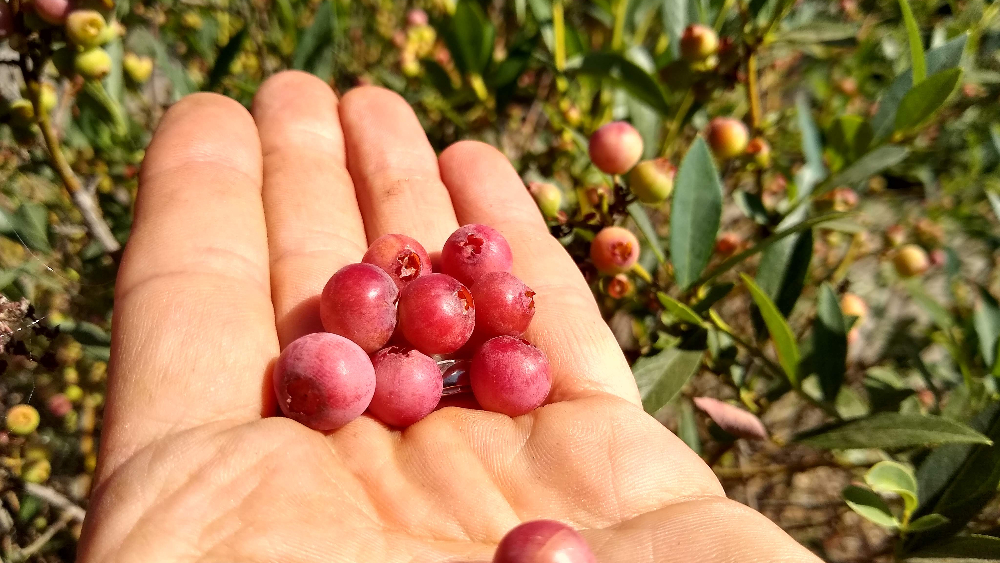


I feel pink lemonade has a very berry flavor compared to some of the varieties you mentioned that I also grow. The birds tend to leave them alone because the color must throw them off. For that characteristic alone one should grow it.
Thank you, Dan. I forgot to mention that. I have also noticed that the birds go after the blue berries over the pink.
As any restaurant knows, presentation is major! I imagine a mix of pink and blue berries piled onto slightly melted vanilla ice cream. Birds made me give up on blueberries, even though they were highly productive in the acidic soil made with peat moss and some sulfur in large pots.
A side note on fabric pots and heat. Fabric pots aka bags keep cool on the hottest days in full sun. I have a couple of baby avocado trees I’m keeping in10-gallon fabric pots over the summer until it cools down. Using a compost thermometer, the soil stays about 70F on the hottest days and the trees are thriving and flushing. It’s surprising. I have lost baby trees to heat when in the ground but these rascals are cool cats!
Greg,
I have several Pink Lemonade inter-planted with other (blue) blueberries. As you noted they are sweeter than a regular blueberry. It is an average producer for me. The only real downside is sunburned limbs. My largest is well over 6’ tall, and the foliage is less pronounced than other varieties. As the fruit develops at the end of the limb; the limb bends downward; thus exposing it to direct sunlight. As a result I have started to paint western facing limbs. Regular blueberries in my location have enough leaf coverage to protect the limbs even under heavy fruit loads.
Even with the extra work I would still plant Pink Lemonade just for the novelty; both small children and the small child inside many of us are drawn to the pinkish-yellow fruit.
Hi Greg—In the photos your blueberry plants appear to be planted in-ground. (Or are they in buried pots?) How do you keep your plant roots in an acidic environment so that they thrive? All mine are in pots in a mixture of peat, coir, and perlite, but I would love to plant them in ground.
Hi Melinda,
Yes, my blueberry plants are in the ground. In summary, I just add a little sulfur to the surface of the dirt under the plants each year. But see details in this post: https://gregalder.com/yardposts/growing-blueberries-in-southern-california/